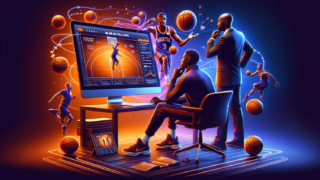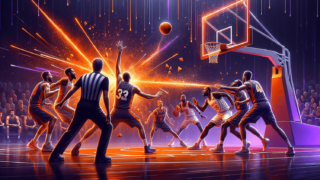
Welcome to the ultimate guide for boosting your basketball foot speed! If you’re craving to enhance your agility, quickness, and overall performance on the court, you’ve come to the right place. In this comprehensive blog post, we’ll explore the game-changing exercises and techniques that will help you stride past your opponents with ease. So, lace up your sneakers and get ready to elevate your game as we dive into the world of basketball foot speed mastery, all while keeping things fun and professional. Let’s get your basketball shoes racing!
How to Improve Your Basketball Foot Speed?
To improve your basketball foot speed, focus on developing lower body strength, flexibility, and balance. Incorporate exercises like squats, lunges, and plyometrics into your training routine to build explosive power. Enhance your agility with ladder and cone drills, while practicing change-of-pace moves during basketball-specific exercises. Lastly, include sprints and conditioning workouts to boost your overall athleticism and endurance on the court.
Mastering the Fundamentals of Basketball Foot Speed
Improving your basketball foot speed begins with a solid foundation. It’s essential to understand the fundamentals of basketball movement and the physical requirements it demands. The better you grasp these concepts, the more effective your training regimen will be. Let’s have some fun and break it all down!
Proper Body Mechanics and Agility
Maintaining correct body posture while moving on the court is crucial for maximizing your foot speed. Maintaining a low stance with your knees bent, chest up, and eyes forward allows for quicker and smoother transitions between different movements. Agility is the ability to move swiftly and change directions rapidly while maintaining control over your body. Perfecting your agility is indispensable for basketball players looking to increase their foot speed.
Explosive Power for Quick Acceleration
Traveling across the court at breakneck speed requires explosive power. This is the ability to generate force in a short amount of time, which is particularly valuable when sprinting, jumping, or changing directions. By incorporating power-focused exercises into your training routine, you can dramatically improve your acceleration and, in turn, your overall basketball foot speed.
Enhanced Balance and Stability
As a basketball player, you’ll often find yourself in positions that require exceptional balance and stability. Strengthening these elements will allow you to maintain control over your body, even when faced with fast-paced and unpredictable gameplay. Ultimately, this increased control and stability lead to better foot speed on the court.
Supercharge Your Lower Body Strength & Flexibility
A robust lower body is critical for basketball foot speed. Strengthening the muscles in your legs, hips, glutes, and core can significantly improve your power, balance, and stability. Incorporating flexibility exercises can help reduce injury risk and enhance your overall athleticism.
Building Leg and Hip Strength
Focusing on your legs and hips can greatly impact your basketball foot speed. Strengthening these areas will not only improve your agility but also allow you to generate more force when accelerating or changing directions. Key exercises for leg and hip strength include:
- Squats and variations
- Lunges
- Deadlifts
- Single-leg exercises
- Hip thrusts
Boost Your Core Strength
When considering foot speed, it’s important not to overlook the role of core strength. A strong core provides stability and forms the foundation for every movement you make on the court. To help you become unstoppable on the court, include some of the following core exercises:
- Planks and variations
- Russian twists
- Leg raises
- Abdominal rollouts
- Mountain climbers
Enhance Flexibility for Maximum Mobility
Improving flexibility is vital for athletes, particularly in a game like basketball that requires dynamic movement. Greater flexibility allows you to move with more freedom, which ultimately results in better foot speed. Aim to engage in a consistent stretching routine, incorporating both dynamic and static stretches to target various muscle groups. Here are some excellent flexibility exercises to include:
- Hamstring stretches
- Quadricep stretches
- Groin stretches
- Hip flexor stretches
- Calf stretches
Agility Drills for Lightning-Fast Movement
To become a basketball speed demon, it’s crucial to develop your agility through targeted drills. These exercises enable you to move effortlessly in all directions, providing you with the upper hand against your opponents. Let’s dive into some agility drills that will leave your rivals in the dust!
Ladder Drills for Speed & Precision
Agility ladder drills are a fantastic way to improve foot speed, coordination, and quickness. Practicing various patterns and footwork will train your body to execute rapid movements with precision. Here are a few ladder drills to try:
- The Ickey Shuffle
- Two-in, Two-out
- In-In-Out-Out
- Single-Leg Hops
- Lateral High Knees
Cone Drills for Directional Change Mastery
Quick and efficient directional changes are essential for basketball foot speed. Incorporating cone drills into your training will help you become a master of stopping on a dime and changing directions effortlessly. Some effective cone drills include:
- Suicide Sprints
- T-Drill
- 5-10-5 Shuttle Run
- Figure-Eight Dribbling
- Four-Corner Box Drill
Plyometric Workouts to Elevate Your Explosiveness
Plyometric training is designed to improve your explosive power by focusing on rapid muscle contractions, which directly corresponds to better foot speed. These exercises involve quick, powerful movements and typically include jumping or hopping. Let’s break down some essential plyometric workouts:
Lower Body Plyometrics
Here are some potential lower body plyometric exercises that will transform you into a basketball speed powerhouse:
- Box Jumps
- Depth Jumps
- Single-Leg Bounds
- Weighted Squat Jumps
- Skater Jumps
Upper Body Plyometrics
Although foot speed is primarily focused on lower body movement, enhancing your upper body explosiveness is valuable for overall athleticism on the court. Add these exercises to your workout routine:
- Plyometric Push-Ups
- Medicine Ball Chest Pass
- Medicine Ball Slams
- Clap Push-Ups
- Explosive Pull-Ups
On-Court Drills to Translate Your Speed into a Basketball Setting
In addition to general fitness and agility training, it’s essential to practice sport-specific drills that translate your newly developed foot speed into a basketball environment. These drills will challenge you to apply your foot speed directly to game situations and improve overall gameplay.
Change-of-Pace Drills
Change-of-pace drills are designed to train your ability to manipulate your foot speed while maintaining control of the ball during gameplay. By being able to quickly accelerate, decelerate, and change speeds, you can easily catch your opponents off guard. Some excellent change-of-pace basketball drills include:
- Hesitation Moves
- Stop-and-Go Dribbling
- Inside-Out Dribble Into a Sprint
- 3-Speed Dribbling
- Dribble-Sprint-Backpedal Drill
Defensive Speed Drills
Foot speed is essential not only on offense but on defense as well. Utilize these challenging on-court defensive drills to maximize your defensive prowess:
- Closeout Drills
- Zigzag Slide Drills
- Defensive Shuffle Sprints
- Mirror Drill
- Tap, Slide, and Sprint Drill
Speed Training and Conditioning
Lastly, incorporating speed training and conditioning into your routine will help you build endurance and overall athleticism. These drills are crucial for maintaining your elevated foot speed throughout the entirety of a basketball game.
Interval Sprints
Interval sprints are a fantastic way to improve speed, explosiveness, and endurance. By alternating between periods of high-intensity sprinting and active recovery, you can push your body to new limits and improve your overall foot speed. Try some of these interval sprints variations:
- 5-5-5 Interval Sprints
- Fartlek Training
- Sprint-Pause-Jog
- 100m, 200m, and 400m Intervals
Conditioning Drills
Conditioning drills give you the stamina needed to maintain a high level of foot speed throughout the game. Members of the basketball world never rest, so neither should you when training! Here are some conditioning exercises worth including in your regimen:
- Line Drills
- Full-Court Sprints
- Carioca Drills
- Carbohydrates: Aim for nutrient-rich, complex carbs like whole grains, fruits, and vegetables.
- Proteins: Consume high-quality protein sources such as lean meats, fish, beans, and nuts for optimal muscle recovery.
- Fats: Opt for healthy fats like avocados, nuts, seeds, and olive oil for sustained energy.
Additional Tips for Boosting Your Basketball Foot Speed
Now that we’ve delved deep into the essential components for improving your basketball foot speed, let’s check out some additional strategies to help elevate your game to new heights.
Nutrition and Hydration: Fuelling Your Performance
While we’ve covered training strategies, it’s essential to recognize the importance of nutrition and hydration in optimizing your basketball foot speed. Proper fuel and hydration can dramatically impact your performance on the court, ensuring you maintain high energy levels allowing you to move quickly and efficiently.
Fueling Up: Essential Nutrients for Basketball Players
A balanced diet is crucial for basketball players striving to improve foot speed. Key macronutrients such as carbohydrates, proteins, and fats all play an essential role in the recovery and performance cycle. When planning your meals, consider the following tips:
Staying Hydrated: The Key to Sustained Performance
Proper hydration is paramount for basketball players. Water helps maintain optimal body temperature and lubricates joints, both of which are important for sustained performance on the court. Consuming adequate fluids throughout the day and during practice or competition ensures you remain quick on your feet. Aim to drink water consistently throughout the day and especially during workouts for peak performance.
Rest and Recovery: The Path to Increased Foot Speed
In pursuit of improved basketball foot speed, don’t forget the importance of rest and recovery. Providing your body time to recover and repair damaged muscle tissue is crucial in gaining the benefits of the exercises and drills outlined in this article.
Active Recovery: Keep Your Body Moving
Although foot speed and agility training can be intense, it’s important to balance those efforts with low-impact exercises on your off days. Engaging in activities such as light swimming, biking, walking, or yoga can help maintain blood flow and promote recovery without adding excessive strain on your muscles.
The Importance of Sleep
Quality sleep is a vital aspect of rest and recovery for athletes. Aim for 7-9 hours of sleep per night to ensure the body gets the proper time it needs to rejuvenate, while also benefiting general cognitive function, mood, and immune health.
Consistency and Patience: The Ultimate Recipe for Success
The journey to improving your basketball foot speed is a combination of the right training approach, nutrition, and recovery. By incorporating the strategies and exercises provided in this article, you can significantly enhance your agility and quickness on the court. Remember, consistency and patience are critical in seeing results; stay committed to your training and continue to push your limits.
Frequently Asked Questions
Let’s address some common questions related to improving your basketball foot speed. These FAQs will help you gain further insight into the topic and enhance your understanding of the various components involved in boosting your agility and quickness on the court.
1. How long does it take to see improvements in foot speed?
Individual results may vary, but with consistent engagement in the exercises and drills detailed in this article, you can expect to see noticeable improvements in foot speed within several weeks to a few months. The key is to remain committed to your routine and stay patient!
2. Can taller basketball players increase their foot speed?
Yes, taller basketball players can definitely improve their foot speed. While a player’s height may impact their natural agility, consistent engagement in targeted exercises and drills can help anyone, regardless of their size, enhance quickness and overall athleticism.
3. How often should I perform agility drills?
To maximize foot speed improvements, aim to perform agility drills at least 2-3 times per week. Be sure to allow for adequate rest between sessions to ensure proper recovery and avoid overtraining.
4. How much should plyometrics be incorporated into my training routine?
Including plyometrics once or twice per week in your training regimen is generally sufficient for improving explosiveness. It’s best to focus on quality rather than quantity to prevent injury and overtraining.
5. Are there any additional tools that can help me with foot speed training?
Many athletes find that using a resistance band or a parachute can help increase their foot speed by adding resistance to their exercises. Incorporating these tools into workouts like sprints and agility drills can help create a more challenging and effective training experience.
6. How important is flexibility for foot speed?
Flexibility is essential for foot speed because it allows you to move more freely through a greater range of motion. Increased mobility can help you perform your speed exercises more effectively and enable you to quickly switch directions on the court.
7. Should I work on foot speed training during the basketball season?
It’s a good idea to continue working on your foot speed during the basketball season but with a reduced intensity in comparison to your off-season training. Maintaining a regular routine while continuing to hone your skills on the court will help you maintain and further improve foot speed.
8. Can video analysis assist in improving my foot speed?
Video analysis can be a valuable tool for identifying areas in need of improvement in your footwork, body mechanics, and overall performance. Studying your movements alongside your coach or a qualified professional can help you make necessary adjustments in your form to maximize your foot speed.
9. What’s the role of mental training in improving foot speed?
Mental training can play a significant role in improving foot speed by enhancing focus, motivation, and overall mental resilience. Practicing visualization, meditation, and positive self-talk can help you stay engaged in your training, overcome barriers, and optimize your performance on the court.
10. Can shoes make a difference in foot speed?
While shoes can impact comfort and overall support, they won’t directly improve foot speed. However, investing in suitable basketball shoes that fit well, provide adequate cushioning and stability, while also being lightweight, can help you maximize the potential of the foot speed training you’ve engaged in.
Featured Posts
- No pillar pages found.





